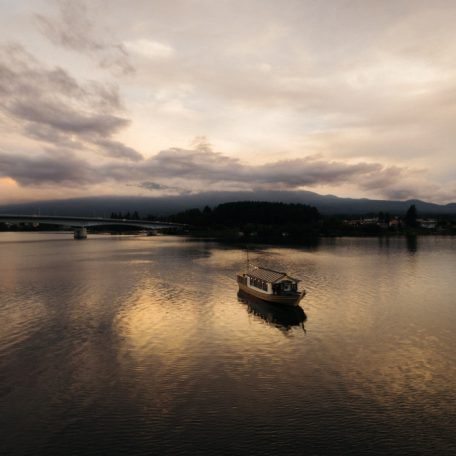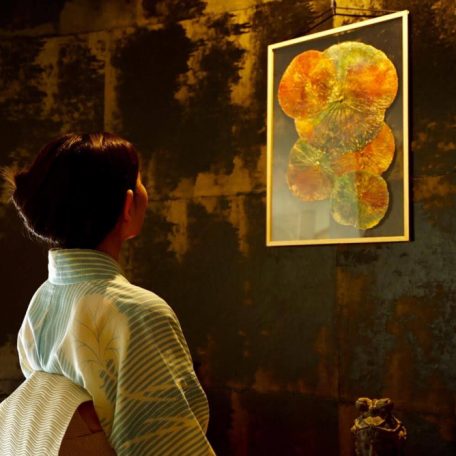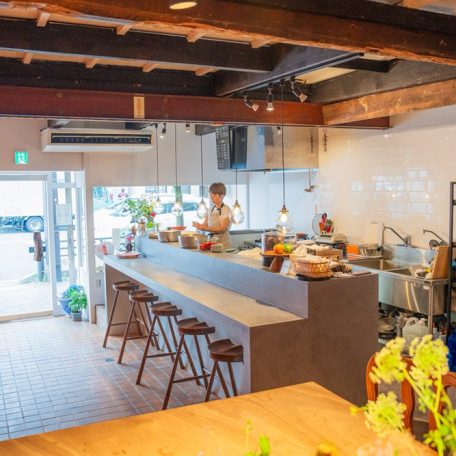Traditional Japanese Tea Ceremony with a Belgian Tea Master in Kyoto
Sep 21, 2019
BY Jessica Iragne

1. Today we are really excited to interview Tyas Sosen, a Tea Master in Kyoto. Can you please introduce yourself?
12 years ago I relocated from Belgium to Japan. I grew up in Antwerp and studied Japanology at the University of Leuven. My first visit was an exchange to Kansai University in Osaka where I experimented with different traditional martial-, and performance arts. This is what led me to discover the Japanese tea ceremony and shaped the path for me to devote my life to Japanese tea culture and to become a tea master in Kyoto.
As a kid I regularly got bad grades and had no real purpose in life. I’d rather hang out with friends and go to pubs than to study and go to school. Around the age of 16 I discovered the Japanese martial art Kendo, which changed the course of my life 180 degrees. For the first time I found something that really interested me. And it was the novel by Eiji Yoshikawa, “Miyamoto Musashi” that drove me to choose to study Japanese, participate in an exchange program to Japan, and eventually get a master’s degree in 17th Century Japanese literature.
2. When and why did you decide to move to Japan? Was it to become a Tea Master from the beginning or were you thinking about just coming to Japan and see what would happen next?
The decision to move to Japan was already made at the time I discovered Kendo, although I had never been and didn’t know what to expect. Somewhere internally it felt right, and if I was going to do something with my life I knew that this would be the right thing to do. In comparison to my life at that time, I didn’t need much to be convinced that taking another route was for the better. I was bored, averse of society, frequented the pub more than I went to school; in short, I rebelled against everything around me and wasted my hours waiting for someone to give me guidance and purpose.
The encounter with Kendo was that little push I needed to open myself up and reveal my full capacity. In a way I had been waiting for something fun, exciting and meaningful to engage in so that I could finally part with my boring, negative life and replace it with a positive drive to make my contribution through doing what I do best.

Once in Japan, I looked to learn more about what Japan’s culture is and attempted to do that through practicing various arts amongst which Karate, Jodo (the way of the staff), Noh performance, and Igo (strategic board game) were the first I went to. I believed that engaging in several practices simultaneously, I would get a broad outlook on Japan’s tradition and get a better understanding of the culture as a whole.
But to my disappointment, each art had the tendency to narrow down and focus on the aspects that were immediately relevant to that practice. When I discovered tea ceremony, I immediately felt that this was different. The practice in itself is so extensive that it envelops a broad variety of traditional arts and crafts. Therefore, as you practice the ritual, you don’t only learn about the proper form and execution, but also are required to study about – to name a few – pottery, lacquer work, bamboo craft, woodwork, iron casting, cookery, architecture, garden design, flower arrangement, and calligraphy (which requires an extensive study and understanding of Zen Buddhism and literature).
To me it was the environment I had been looking for. Practicing the tea ceremony gave me the opportunity not only to deepen my understanding of the ritual, but simultaneously to expand my knowledge into other areas of Japanese culture because of its relation to the practice. In essence, I have come to feel that the tea ceremony is a microcosm of Japanese culture as a whole. And that through studying the ritual, we can become acquainted with what Japan as a culture can teach us; some of which very valuable lessons that still apply to our present day lives.
3. What is the thing that surprised you the most when you first arrived in Japan?
Before I came to Japan I had been studying Japanology in Belgium. We had Japanese teachers and Belgian teachers who had lived in Japan for an extensive period of time for our 24 hours (per week) of Japanese language classes. In addition, we had classes on Japanese literature, history, religion, society, politics, etc. I think that the understanding and appreciation for Japan before I even set foot in this country was much more profound than any other regular visitor. Therefore, thanks to my education, I already knew what to expect and skip the initial culture shock so I could step into regular life right away.

To recount a fun episode, during our schooling in Japanese language, we received thorough speaking and listening practice on everyday topics. One of the subjects we practiced was “how to rent an apartment”. In the video we used the subject went to a real estate agent and rented an apartment in Japanese. From this we gathered the vocabulary and mastered the skill to converse on the topic.
During the first week in Japan, I rented two apartments, one for me and some friends and one for a fellow couple, solely relying on the skills we had learned in this class. The funny part is that I even got a discount on the rent. To make a long story short, I think I was too well informed to really experience any surprises.
4. You are now qualified as a Tea Instructor here in Japan, I guess it was a long process. Can you please tell us more about it?
I have been studying the tea ceremony for an extensive period of time. 12 years to be exact, since the time I relocated to Japan. However, I never had the intention to get a certification of any sort. By this I mean it was never my goal to strive to achieve instructorship, nor did that thought ever cross my mind as I was practicing. My personal goal as an adept of the tea ceremony was always simply to enjoy the engagement with this centuries old tradition, and to make my contribution to its preservation through practice.

However, when my teacher instructed me to receive instructorship, I happily accepted. To me this meant the opening of a new door to further my practice and understanding of this tradition, rather than it to simply mean the closing of the chapter of apprenticeship. To be able to teach something is much more difficult than being able to properly execute it.
To me this accreditation meant that I could further my practice through teaching others. It also instilled in me a responsibility to do my part in making this ritual accessible and understandable within and beyond the borders of Japan.
5. Are there a lot of foreigners who have gotten that certification in Japan?
There are only a few, and most don’t do anything actively with it. The Enshu school – which I practice – and which is one of 12 major tea ceremony traditions, has fewer foreigner instructors than for example the Ura Senke tradition, which has teachers in most major cities throughout the world.
6. Can you please let us know about the Tea Experiences you are offering in Kyoto?
We provide two types of engagement with traditional Japanese tea culture in Kyoto.
- The first is an authentic tea ceremony occasion that lasts approximately 1.5h. Throughout this activity we will help you to cognitively understand its culture by providing thorough explanations in English. But mainly we will allow you to feel the emotional energy that works underneath the surface of such an intimate gathering. This activity is hosted at our traditional Japanese teahouse hidden away at the rear of the precincts of a small temple.
- My other activities are the tea counter at our 100-year old Japanese townhouse. While you may sit comfortably on a chair – instead of on traditional straw-matted flooring – you can choose to either receive an introduction to the tea ceremony or participate in a dedicated tasting of Japan’s most unique artisan teas.
7. Why would you recommend travelers to join?
As masters and devoted teachers of the Japanese tea ceremony, we make it our first concern to provide for our visitors and students an authentic engagement with this art. Instead of limiting them to mere outsider spectatorship, we strongly believe that whoever has chosen to visit the cultural capital of Japan, Kyoto, should at least receive informed guidance in engaging fully with one of the traditional practices available in this city.
At Tea Ceremony Kyūgetsu it is our mission to make the rite of tea accessible, comprehensible and enjoyable for whoever chooses to visit us. This we do not only through offering an elegantly-expert service of tea, but also by bringing our guests to discover, through full immersion-participation, the spiritual and emotional effects afforded by such a service, helped by detailed explanations in competent English.  In sharing with foreign visitors our understanding of this unique form of hospitality, our goal extends beyond increasing worldwide appreciation of this rite, and indeed of traditional Japanese culture as a whole. For we believe that engagement with Tea is engagement with the wisdom of our forebears, doing which can be of invaluable assistance in resetting the paradigms through which we see the world, and in effect help make this world a better place.
In sharing with foreign visitors our understanding of this unique form of hospitality, our goal extends beyond increasing worldwide appreciation of this rite, and indeed of traditional Japanese culture as a whole. For we believe that engagement with Tea is engagement with the wisdom of our forebears, doing which can be of invaluable assistance in resetting the paradigms through which we see the world, and in effect help make this world a better place.
8. What is your favorite Japanese food? Do you miss food from Belgium?
I enjoy very simple, basic cuisine. I am perfectly happy with a bowl of rice with a pickled plum atop for lunch. Otherwise, I will never say no to Buddhist vegetarian Shojin cuisine, and am a huge stickler for both Tofu and Soba. Belgian foods I don’t necessarily miss, although I do occasionally like to enjoy some good cheese, which is immensely overpriced in Japan.
9. What do you think about food tours?
Everyone needs to eat. Even when a foreign visitor participates in a regular tour, he/she will want to know where to go for lunch or dinner. Getting a feel for the local cuisine is an important aspect of getting to know a country and its customs. Therefore I feel it is of added value to take a tour where specific attention is also given to the foods that are enjoyed, in addition to the sights that are seen along the way. To me a combination of both sightseeing and food are vital to a good tour. And preferably they are in theme with one-another.
10. Thanks a lot for your time and answers. Please feel free to add anything you want to share about you or Japan with our readers and followers!
As human beings we need time to reset, to relax and to take a breath. We can’t continue moving forward at all times. Sometimes we need to pause for a moment to refuel, or we need to stand still to be able to fully take in what is going on in our immediate surroundings. Doing all this ‘on the go’ is immensely exhausting.Taking a moment of time each day to prepare a bowl or cup of tea allows you a moment to let go of all stress and worries as you simply focus on preparing the tea and mindfully savor the brew.
It realigns us with the present and helps us to readjust our focus. Often you may find that by momentarily letting go of all the problems you are handling that, when you return to them you may discover something you hadn’t seen before or that you see them in a slightly different light.
More info about him and his company:
If you’re a tea lover and traveling to Kyoto, be sure to join our Matcha food tour!
Book your pocket wifi now to stay connected through your entire Japan Journey!

Be sure to get the JR Pass to make navigating Japan during your trip that much easier!






